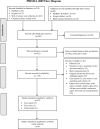Antifungal therapy in the management of fungal secondary infections in COVID-19 patients: A systematic review and meta-analysis
- PMID: 35901069
- PMCID: PMC9333218
- DOI: 10.1371/journal.pone.0271795
Antifungal therapy in the management of fungal secondary infections in COVID-19 patients: A systematic review and meta-analysis
Abstract
Objectives: The prevalence of fungal secondary infections among COVID-19 patients and efficacy of antifungal therapy used in such patients is still unknown. Hence, we conducted this study to find the prevalence of fungal secondary infections among COVID-19 patients and patient outcomes in terms of recovery or all-cause mortality following antifungal therapy (AFT) in such patients.
Methods: We performed a comprehensive literature search in PubMed®, Scopus®, Web of Sciences™, The Cochrane Library, ClinicalTrial.gov, MedRxiv.org, bioRxiv.org, and Google scholar to identify the literature that used antifungal therapy for the management fungal secondary infections in COVID-19 patients. We included case reports, case series, prospective & retrospective studies, and clinical trials. Mantel Haenszel random-effect model was used for estimating pooled risk ratio for required outcomes.
Results: A total of 33 case reports, 3 case series, and 21 cohort studies were selected for final data extraction and analysis. The prevalence of fungal secondary infections among COVID-19 patients was 28.2%. Azoles were the most commonly (65.1%) prescribed AFT. Study shows that high survival frequency among patients using AFT, received combination AFT and AFT used for >28 days. The meta-analysis showed, no significant difference in all-cause mortality between patients who received AFT and without AFT (p = 0.17), between types of AFT (p = 0.85) and the duration of AFT (p = 0.67).
Conclusion: The prevalence of fungal secondary infections among COVID-19 patients was 28.2%. The survival frequency was high among patients who used AFT for fungal secondary infections, received combination AFT and AFT used for >28 days. However, meta-analysis results found that all-cause mortality in COVID-19 patients with fungal secondary infections is not significantly associated with type and duration of AFT, mostly due to presence of confounding factors such as small number of events, delay in diagnosis of fungal secondary infections, presence of other co-infections and multiple comorbidities.
Conflict of interest statement
The authors have declared that no competing interests exist.
Figures


Similar articles
-
Antifungal Treatment and Outcome in Very Low Birth Weight Infants: A Population-based Observational Study of the German Neonatal Network.Pediatr Infect Dis J. 2018 Nov;37(11):1165-1171. doi: 10.1097/INF.0000000000002001. Pediatr Infect Dis J. 2018. PMID: 29601449
-
Fungal co-infection in COVID-19 patients: evidence from a systematic review and meta-analysis.Aging (Albany NY). 2021 Mar 19;13(6):7745-7757. doi: 10.18632/aging.202742. Epub 2021 Mar 19. Aging (Albany NY). 2021. PMID: 33744863 Free PMC article.
-
Fungal infection-related conditions and outcomes in severe COVID-19: a nationwide case-control study.BMC Infect Dis. 2024 Dec 18;24(1):1435. doi: 10.1186/s12879-024-10317-z. BMC Infect Dis. 2024. PMID: 39695439 Free PMC article.
-
Worldwide prevalence of microbial agents' coinfection among COVID-19 patients: A comprehensive updated systematic review and meta-analysis.J Clin Lab Anal. 2022 Jan;36(1):e24151. doi: 10.1002/jcla.24151. Epub 2021 Dec 1. J Clin Lab Anal. 2022. PMID: 34851526 Free PMC article.
-
Fungal coinfection/superinfection in COVID-19 patients in a tertiary hospital in Mexico.Biomedica. 2024 Aug 29;44(3):328-339. doi: 10.7705/biomedica.7251. Biomedica. 2024. PMID: 39241240 Free PMC article.
Cited by
-
An observational study on factors associated with ICU mortality in Covid-19 patients and critical review of the literature.Sci Rep. 2023 May 13;13(1):7804. doi: 10.1038/s41598-023-34613-x. Sci Rep. 2023. PMID: 37179397 Free PMC article. Review.
-
Outcomes of Patients with COVID-19 and Fungal Coinfections: A Systematic Review and Meta-Analysis Study.Iran J Pathol. 2024 Spring;19(2):136-147. doi: 10.30699/IJP.2024.2010087.3160. Epub 2024 Feb 15. Iran J Pathol. 2024. PMID: 39118795 Free PMC article. Review.
-
COVID-19 associated with cryptococcosis: a scoping review.Ther Adv Infect Dis. 2024 Feb 14;11:20499361241232851. doi: 10.1177/20499361241232851. eCollection 2024 Jan-Dec. Ther Adv Infect Dis. 2024. PMID: 38361915 Free PMC article.
-
COVID-19 in patients with paracoccidioidomycosis.PLoS Negl Trop Dis. 2023 May 8;17(5):e0011322. doi: 10.1371/journal.pntd.0011322. eCollection 2023 May. PLoS Negl Trop Dis. 2023. PMID: 37155708 Free PMC article. Review.
-
Recurrent Scedosporium apiospermum Cutaneous Infection in a Patient with Rheumatoid Arthritis: The Potent Role of IL-6 Signaling Pathway Blockade: A Case-Based Review.J Fungi (Basel). 2023 Jun 18;9(6):683. doi: 10.3390/jof9060683. J Fungi (Basel). 2023. PMID: 37367619 Free PMC article. Review.
References
-
- Fungal diseases and COVID-19. Centers for Disease Control and Prevention. In: cdc.gov. 2021. https://www.cdc.gov/fungal/covid-fungal.html.
-
- Press Information Bureau. Govt. of Inida. 2021. Available: https://pib.gov.in/PressReleseDetailm.aspx?PRID=1718501.
Publication types
MeSH terms
Substances
LinkOut - more resources
Full Text Sources
Medical

